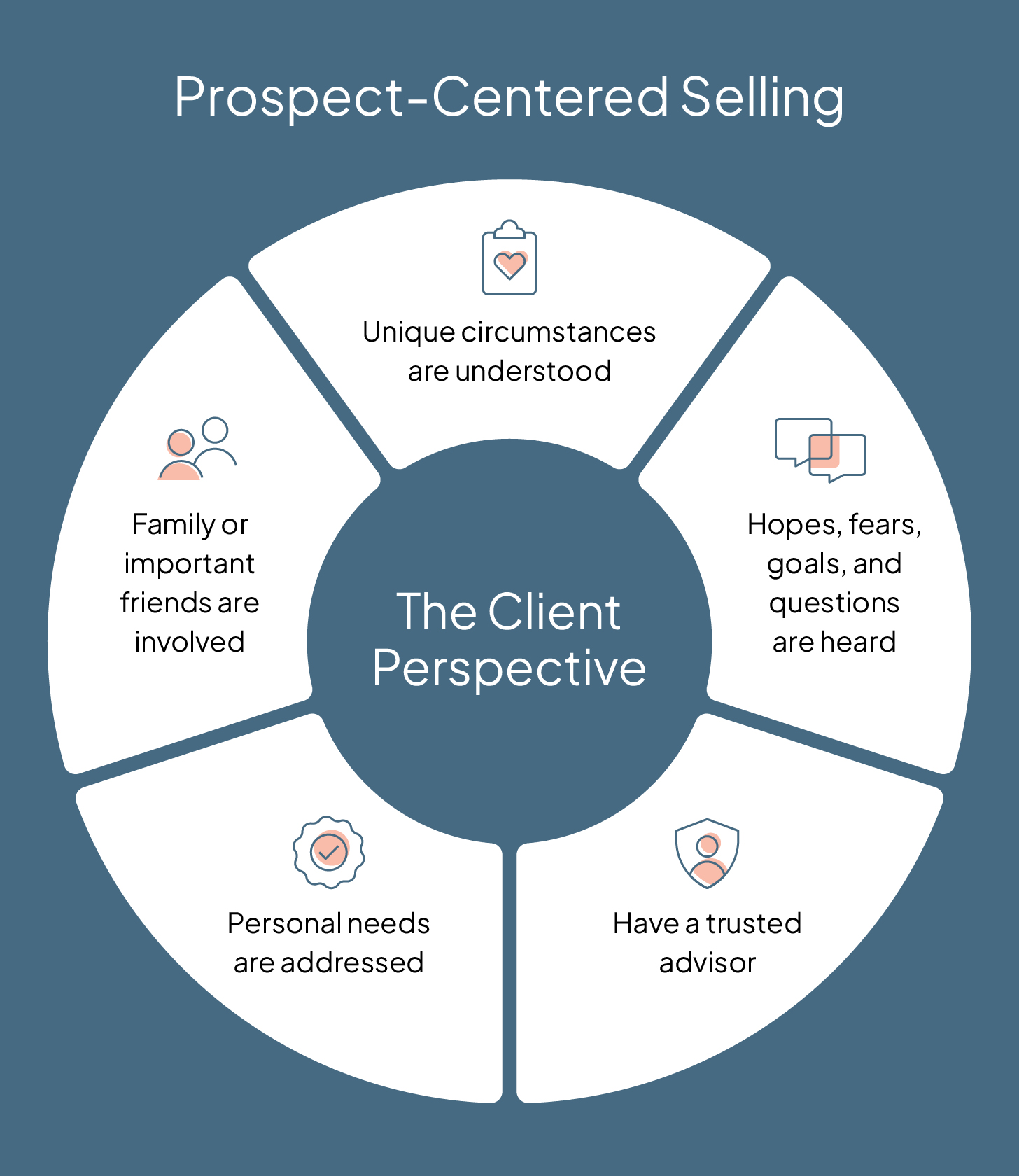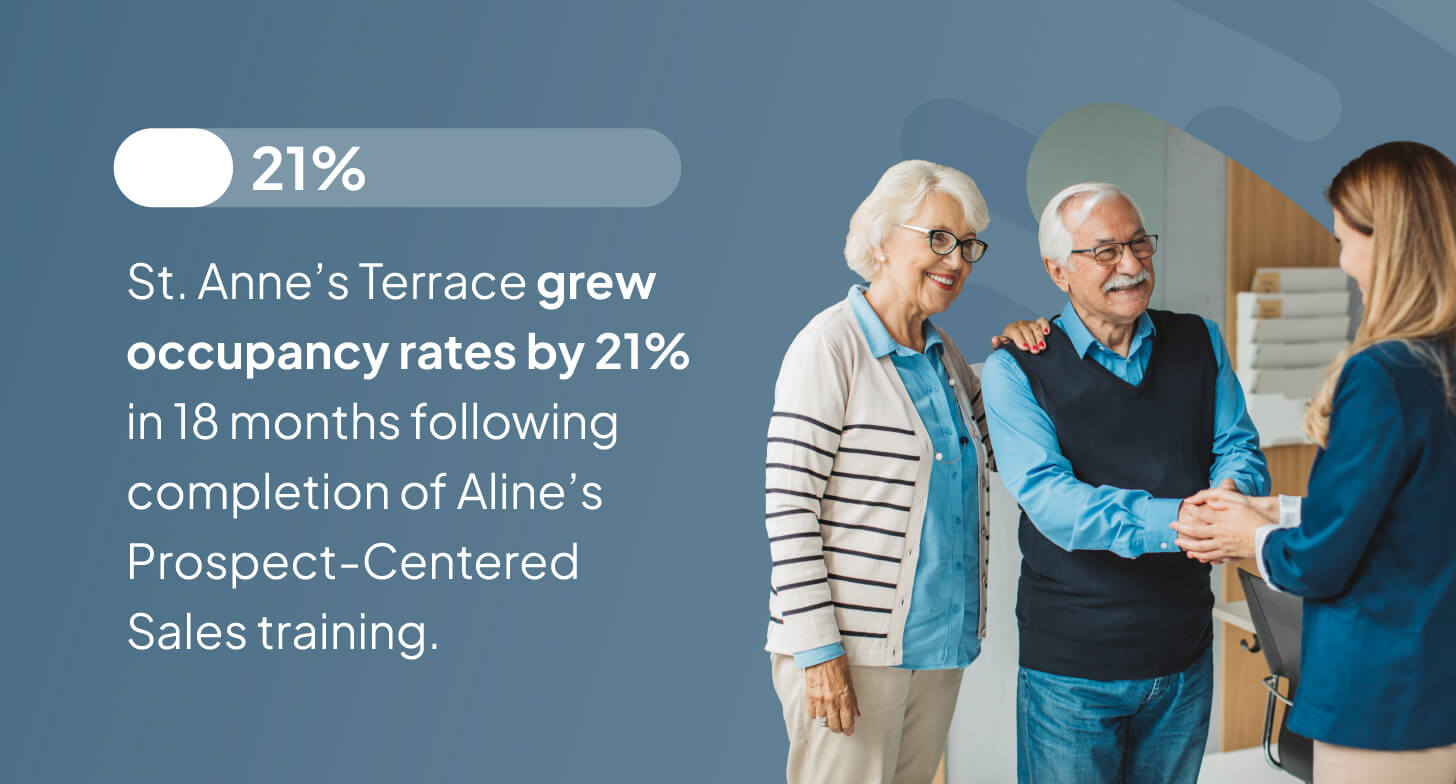Prospect-Centered Selling: A Guide for Senior Living Operators
Prospect-centered selling helps senior living operators convert more leads and achieve occupancy goals through a more personalized, empathetic approach.

Prospect-centered selling helps senior living operators convert more leads and achieve occupancy goals through a more personalized, empathetic approach.
Published on: September 16, 2025
Last updated: October 22, 2025

Senior living is mission-driven at its core—but financial sustainability is equally critical. According to the Aline 2025 State of the Senior Living Industry Report, 61% of operators said they’re adjusting pricing to balance affordability with profitability.
Here’s how many are managing that balance today.
While these strategies help manage costs and improve profit margins in the short term, another approach can help in the long run: prospect-centered selling.
Unlike broad marketing approaches, prospect-centered selling recognizes that choosing a senior living community is a deeply personal decision. By focusing on each prospect’s unique priorities and emotional drivers, this approach builds stronger relationships, supports sustainable occupancy, and helps providers protect both mission and margin.
Prospect-centered selling is a sales approach that places the prospect at the heart of every interaction. Unlike traditional strategies that rely on broad messaging, discounts, or generic campaigns, prospect-centered selling is about uncovering and addressing each prospect’s unique motivations.
In senior living, this means addressing prospects’ practical and emotional needs first and then connecting those needs to your own sales goals.
Some key aspects of prospect-centered selling in connection to senior living include:

Cypress Cove Life Plan Community, founded in 1933, a continuing care retirement community in Fort Myers, Florida, serving more than 650 residents that serves over 650 residents. In 2020, Michael Moss stepped in as vice president of sales and marketing and quickly found that he and his team faced three key challenges.
To overcome these hurdles, Cypress Cove participated in the Aline Prospect-Centered Selling® training program. Reflecting on the shift, Moss shared:
Cypress Cove shifting to Prospect-Centered Selling propelled our sales culture and approach with our prospective residents. We worked our new leads with heightened awareness, intentionality, and focus on the prospect-centered selling process.Michael Moss, Vice President of Sales, Cypress Cove Life Plan Community
The results went beyond a cultural shift. Within six months of completing the Aline Prospect-Centered Selling training, independent living occupancy rose from 87–90% to 95% — the highest rate in six years. By March 2023, occupancy climbed even further with 97% of units sold.
As the Cypress Cove example shows, prospect-centered selling offers a range of strategic benefits that work together to support sustainable growth. These benefits often start with small, strategic closes that build trust and partnerships—ultimately paving the way for the larger decision to move in.
Traditional sales approaches often emphasize quantity — how many tours are given or how many leads are contacted. Prospect-centered selling shifts the focus to quality, measuring the “meaningful time” a sales rep spends truly understanding a prospect.
This distinction matters. For example, the Aline 2024 Benchmark Report found that 55% of adult children cite safety as a top priority when evaluating senior living options for their parents while only 12% of older adults feel the same way. Without a prospect-centered approach, these nuances are easily overlooked. By taking the time to uncover each person’s perspective, sales teams build the kind of trust that strengthens relationships and leads to better outcomes.
Once you establish trust, prospects are more willing to open up about their hopes, concerns, and even sensitive details, like financial readiness. They may be ready for longer conversations, home tours, and deeper engagement.
Still, many families struggle to connect their needs with specific care services or community features. Prospect-centered selling equips sales teams to bridge that gap, helping families clearly see how their priorities, whether safety, social engagement, or future care transitions, align with what your community offers.
According to Aline’s 2024 Benchmark Report, moving a prospect from inquiry to move-in typically takes an average of 23 activities, including three face-to-face meetings and six voice-to-voice interactions. The takeaway is clear: Longer, more meaningful conversations lead to stronger connections, higher move-in rates, and long-term resident satisfaction.
And, of course, ensure all your tech, including CRM software, marketing software, and contact centers, is built specifically for senior living, helping you support prospect-centered selling techniques. Look for prospect-centered sales training where possible, to help hone your skills.St. Anne’s Terrace, an Atlanta-based senior living community, grew its occupancy rates 21% within 18 months after completing Aline’s Prospect-Centered Sales training program.
With trust built, needs addressed, and satisfaction achieved, prospects are ready to move in confidently. Prospect-centered selling creates a chain reaction as deeper engagement leads to higher satisfaction, which leads to longer stays and stronger occupancy.
Over time, each of these steps compounds, transforming a thoughtful, relationship-focused sales approach into steady revenue growth. The financial benefits are clear as well: Lead conversion costs through prospect-centered selling are significantly lower than traditional methods, such as referrals, which can reach $2,001–$5,000 per move-in.
Prospect-centered selling isn’t just about mindset—it also requires practical strategies and systems that support a more personal approach. Below are some tips to help sales teams put this sales methodology into action.

Like any strategy, you need to measure prospect-centered selling to confirm your efforts are producing meaningful results. Tracking the right metrics at the right cadence helps you see what’s working, identify gaps, and avoid drowning in unnecessary data.
Measure these key metrics to align your sales process with both resident satisfaction and business goals.
Pro tip: Use industry benchmark data to optimize sales performance.
Benchmarking data from solutions like Aline Market Insights can help you compare performance in real time. For example, if your community averages five initial tours per month per 100 units, but the industry benchmark is 7.7, you know it’s time to re-evaluate your strategy. You can also load benchmarks into your CRM to automatically flag when performance falls below industry standards, helping you act before small issues become big problems.
Prospect-centered selling reshapes how senior living operators connect with families by keeping their needs at the heart of the sales process. Prioritizing meaningful interactions over volume-driven activities builds stronger relationships, supports sustainable occupancy, and improves resident satisfaction.
That’s where Aline CRM With Prospect-Centered Selling can help. Purpose-built for senior living, it helps teams track meaningful interactions, capture family dynamics, and align sales goals with what matters most to prospects. From small closes to full move-ins, your team has the structure and insights to build trust and boost conversions.
Let’s talk about how Aline CRM With Prospect-Centered Selling can help you turn this approach into stronger relationships, higher occupancy, and lasting success in your community.

Amanda McGrory-Dixon
Amanda McGrory-Dixon is the content marketing manager at Aline, where she shares expert insights on how senior living communities can streamline operations, enhance resident satisfaction, and drive sustainable growth. With a deep understanding of industry trends and technology, she helps operators navigate challenges and implement data-driven strategies to improve efficiency, profitability, and care outcomes.
Blogs, stories and studies from the forefront of senior living operations

Lead generation surveys give senior living operators the data they need to understand their market, uncover new opportunities, and drive occupancy growth.

Gain insight into senior living pricing strategies for community success. Explore how Aline’s software optimizes revenue and operations

Overcome the biggest senior living financial challenges, including operational costs and occupancy rates, with interconnected software

Take a look at how senior living software options, like Aline, can elevate operations, resident care, and ROI

Enhance efficiency, accuracy, and resident satisfaction by integrating a POS system into your senior living dining operations

See how emerging dining strategies help senior living communities streamline operations while fostering stronger connections with residents
We’re using cookies on this site to improve your experience. Cookies help us learn how you interact with our website, and remember you when you come back so we can tailor it to your interests.
You can find out more about cookies and usage on our cookie policy page.
Some of these cookies are essential, while others help us to improve your experience by providing insights into how the site is being used.
For more detailed information on the cookies we use, please check our privacy policy
Your experience is important to us. We’re redirecting you to our new Aline website, where you’ll discover how our complete suite of senior living solutions can help you grow occupancy and revenue, optimize operations, and enhance resident care.
For more information, you’re welcome to read our statement on our merger. To continue your web experience, simply close this notification.
Your experience is important to us. We’re redirecting you to our new Aline website, where you’ll discover how our complete suite of senior living solutions can help you grow occupancy and revenue, optimize operations, and enhance resident care.
For more information, you’re welcome to read our statement on our merger. To continue your web experience, simply close this notification.
Your experience is important to us. We’re redirecting you to our new Aline website, where you’ll discover how our complete suite of senior living solutions can help you grow occupancy and revenue, optimize operations, and enhance resident care.
For more information, you’re welcome to read our statement on our merger. To continue your web experience, simply close this notification.
Your experience is important to us. We’re redirecting you to our new Aline website, where you’ll discover how our complete suite of senior living solutions can help you grow occupancy and revenue, optimize operations, and enhance resident care.
For more information, you’re welcome to read our statement on our merger. To continue your web experience, simply close this notification.
Aline Innovation Summit 2026: Registration Now Open!
Connect with senior living leaders, innovators, and industry peers May 11-13, 2026, in Frisco, TX to explore the latest innovations, proven strategies, and best practices shaping the future of senior living. View details and register today.